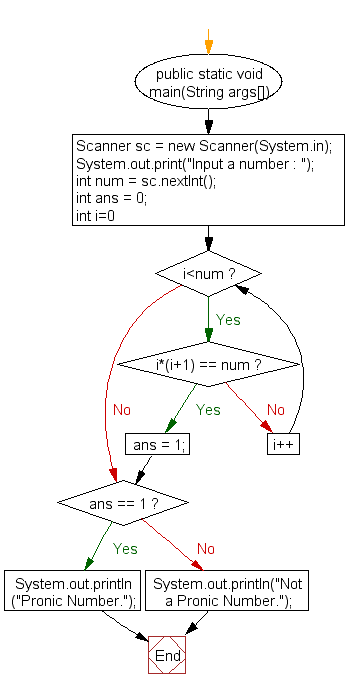Java: Check whether a number is a Pronic Number or Heteromecic Number or not
Check Pronic Number
Write a Java program to check whether a number is a Pronic or Heteromecic Number or not.
A pronic number is a number which is the product of two consecutive integers, that is, a number of the form n(n + 1).
The first few pronic numbers are:
0, 2, 6, 12, 20, 30, 42, 56, 72, 90, 110, 132, 156, 182, 210, 240, 272, 306, 342, 380, 420, 462 … etc.
Test Data
Input a number : 110
Pictorial Presentation:
Sample Solution:
Java Code:
import java.util.Scanner;
public class Example13 {
public static void main(String args[])
{
Scanner sc = new Scanner(System.in);
System.out.print("Input a number : ");
int num = sc.nextInt();
int ans = 0;
for(int i=0; i<num; i++)
{
if(i*(i+1) == num)
{
ans = 1;
break;
}
}
if(ans == 1)
System.out.println("Pronic Number.");
else
System.out.println("Not a Pronic Number.");
}
}
Sample Output:
Input a number : 110 Pronic Number.
Flowchart:

For more Practice: Solve these Related Problems:
- Write a Java program to check if a number is pronic by finding an integer n such that n*(n+1) equals the number.
- Write a Java program to generate a list of pronic numbers up to a specified limit using mathematical formulas.
- Write a Java program to verify the pronic property using a binary search on possible integer candidates.
- Write a Java program to compare loop-based and formula-based methods for detecting pronic numbers.
Go to:
PREV : Check Harshad Number.
NEXT : Check Automorphic Number.
Java Code Editor:
Contribute your code and comments through Disqus.
What is the difficulty level of this exercise?
Test your Programming skills with w3resource's quiz.
